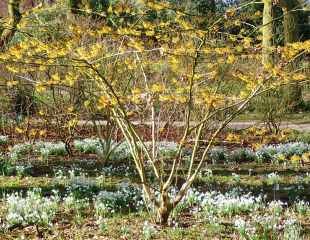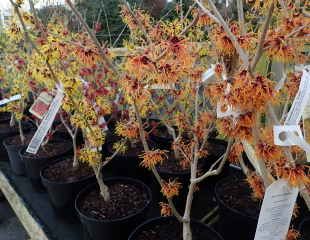How to Grow Hamamelis common name Witch Hazel



Hamamelis is a winter flowering deciduous large shrub or small tree
The image show left Hamamelis in leaf with a strong autumn colour. The centre image is shows the full shrub its general shape and appearance in flower, in a woodland setting, under planted with snowdrops. I took this image at Dunham Massey gardens, which has a wonderful winter garden, well worth a visit. The image right shows the spidery shape of the Hamamelis flowers. It is an unusual shrub.
Most Hamamelis flower in winter and do so on bare branches, the flowers appearing before the shrub comes into leaf, similar to Forsythia. Hamamelis x intermedia and Japonica bear flowers in the winter and have a lovely autumn colour. A bonus is that some varieties have scented flowers, such as 'Vesna' (RHS Merit) a sweet honey scent, 'Barmstedt Gold' (RHS merit) scent described as similar to bergamot, H Mollis 'Wisley Supreme'. Most grow up to around 4 metres, although there are some smaller varieties.
Given that Hamamelis are winter flowering, they look good under planted with Helleborus, snowdrops as in the image, and with spring bulbs to make spring woodland garden.

The image at the top shows Hamamelis in a woodland setting but I have often seen it grown in urban front gardens as illustrated here.
The most commonly grown varieties of Hamamelis are yellow, but there are also varieties which are red, orange and mauve illustrated below. Many varieties of Hamamelis have scented flowers which are good to cut and bring indoors. Hamamelis are slow to get going and can take a couple of years to get established and flower well. Witch Hazel is slow growing about 3-4m in a 10-year period. Witch Hazel is hardy to H5, which is between -10-15C.
Buying a Witch Hazel ShrubHow to ensure you get a scented variety

If you are planting Witch Hazel for winter scent, I recommend you buy a plant in January, when it is in flower. I took the image left at a local garden centre. It had a row of Witch Hazel shrubs for sale, and many were described as "scented" and "highly scented".
I tested this by simply walking along the line with my nose in the flowers. Only one struck me as strongly scented. For this reason, if scent is important, I would not go by the description, but purchase the shrub during its flowering period so you can assess for yourself its scent. (see below H. Pallida did stand out.)
Planting and pruning Hamamelis
Hamamelis will tolerate partial shade, although they bloom better in a sunny position, which is their preferred growing conditions. To establish Hamamelis in an area of partial shade, the other growing conditions need to be suitable. This means fertile, well-drained soil which is neutral to acid, ideally a pH range of 4.5 -6.5.
Witch Hazel is a long-lived and hardy, but dislikes to be in a frost pocket or an exposed area. Hamamelis planted in frost prone area will need protection from frost for the first year or so until established. In addition, until established, Hamamelis Witch Hazel may need watering during dry periods. Once established, it is trouble-free. Plant it at the same depth as its container and ensure you don't bury the graft point.In a sunny area, Hamamelis tolerates other soil conditions better, but it still won't thrive in an exposed area, even though it's described as fully hardy.
The flowers on Hamamelis bloom on last year's wood, (known as old wood) which means that Hamamelis should be pruned immediately flowering. Witch Hazel does not require pruning, but it can be pruned, to restrict its size or remove dead wood. Prune it in early spring after flowering. To reduce its size, remove 2 or 3 longer branches to a side branch to keep a good shape.
Hamamelis are not the easiest of shrubs to get established, and if you feel your garden conditions are not ideal, but are looking for an early flowering yellow garden shrub, Forsythia is a less adventurous but an easier alternative.



Hamamelis vernalis Amethyst which has purple flowers which are lightly scented.
A red flowering Hamamelis, probably H. 'Diane' has the Award of Garden Merit (AGM) and is slightly scented.
Orange flowering of Hamamelis, 'aphrodite' lovely burnt orange with a light scent.
Suggested varieties of Hamamelis to Grow
A good guide as to which varieties to grow is by reference to the RHS Award of Garden Merit.
Between 2014-2016, the RHS conduced trials on Hamamelis at the Witch Hazel Nursery in Kent. 138 cultivars were assessed over 3 years and 17 were granted the RHS award of garden merit. The plants assessed were all mature between 10-20 years old and factors the judges considered were: flower quality based on colour, size and shape, together with the amount of flowers and length of flowering time. The full list is on the RHS website. Listed below are varieties which did well in the trial and are readily available.
Witch Hazel flowering colours are yellow, red and orange. Here is one of each colour, awarded the RHS Award of Garden Merit.
Hamamelis x intermedia 'Arnold Promise' late flowering in February, described as flowering prolifically highly scented lemon yellow flowers with good autumn colour.
H. x intermedia 'Diane' is a red variety, faintly scented, and it forms a bushy shrub of around 2.5m tall and 3m wide. The recommendation is to plant it where the winter sun suns through to back light and illuminate the flowers.
H. x intermedia 'Robert' coppery orange flowers with a good scent.
Also recommended is H. x intermedia 'Pallida' early to mid-season flowering, strong yellow flowers with citrus scent very popular and reliable, with good autumn colour. In the line up above, this is one variety whose scent did stand out.

Hamamelis, Witch Hazel, is tagged Amber Wheelbarrow because it can be slow to get established, requires precise conditions and not too keen on cold exposed condition.
